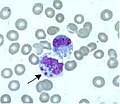Human monocytotropic ehrlichiosis: Difference between revisions
CSV import |
No edit summary |
||
| Line 32: | Line 32: | ||
{{stub}} | {{stub}} | ||
<gallery> | <gallery> | ||
File:Echaff.jpg|Human monocytotropic ehrlichiosis | File:Echaff.jpg|Human monocytotropic ehrlichiosis | ||
</gallery> | </gallery> | ||
Revision as of 00:00, 17 March 2025
Human Monocytotropic Ehrlichiosis is a tick-borne disease caused by the bacterium Ehrlichia chaffeensis. This disease is primarily transmitted to humans by the Lone Star tick (Amblyomma americanum).
Symptoms
The symptoms of Human Monocytotropic Ehrlichiosis typically appear within 1-2 weeks following the bite of an infected tick. Symptoms can include:
- Fever
- Headache
- Muscle aches
- Chills
- Nausea
- Confusion
- Rash (occurs in approximately 30% of adults and up to 60% of children)
Diagnosis
Diagnosis of Human Monocytotropic Ehrlichiosis is based on clinical signs and symptoms, and can later be confirmed with specialized confirmatory laboratory tests. Treatment should never be delayed pending the receipt of laboratory test results, or be withheld on the basis of an initial negative laboratory result.
Treatment
The treatment of choice for Human Monocytotropic Ehrlichiosis is Doxycycline. Doxycycline is most effective at preventing severe complications from the disease if it is started early in the course of illness.
Prevention
Prevention of Human Monocytotropic Ehrlichiosis primarily involves avoiding areas where ticks are found and using insect repellents.



